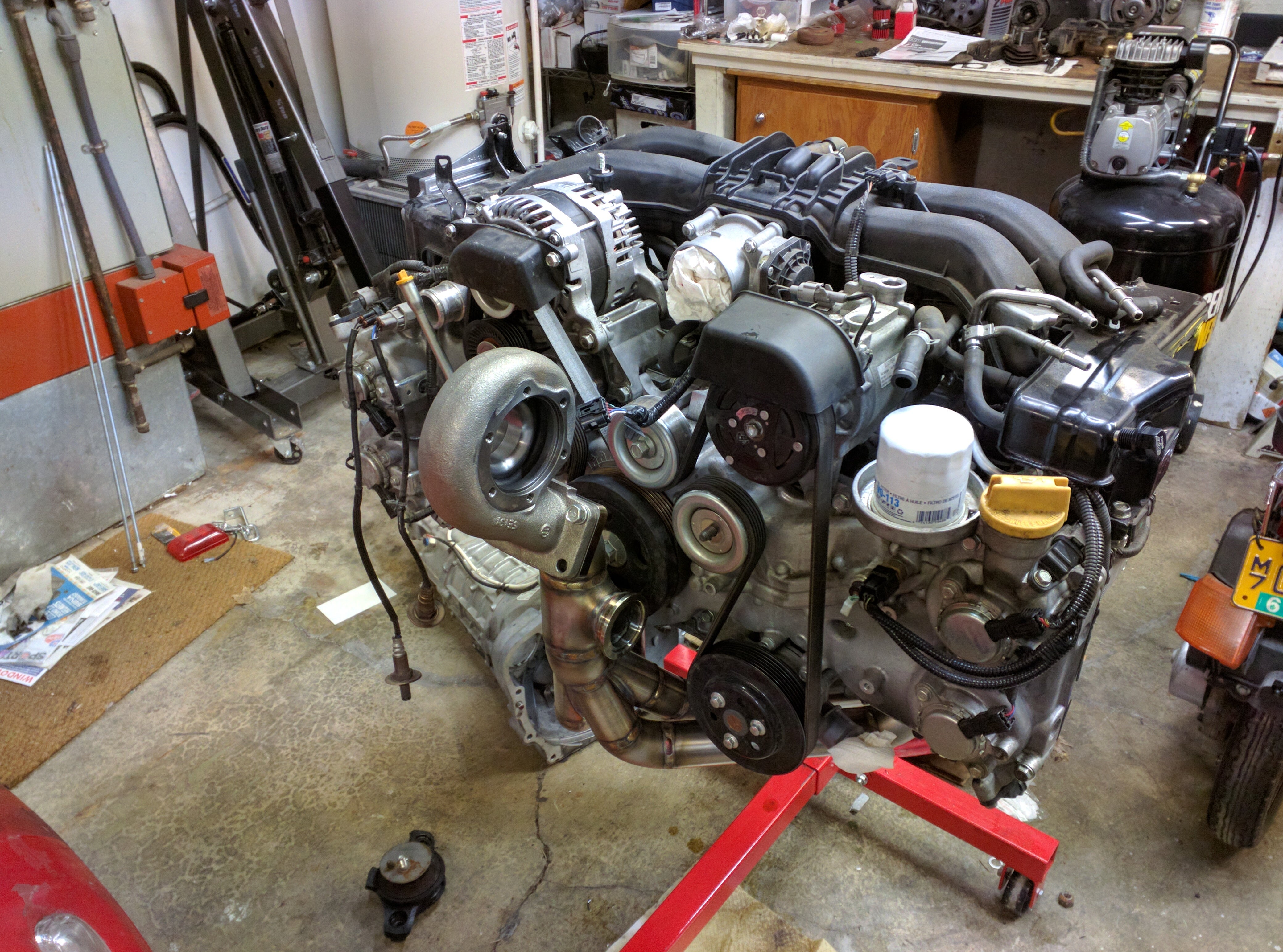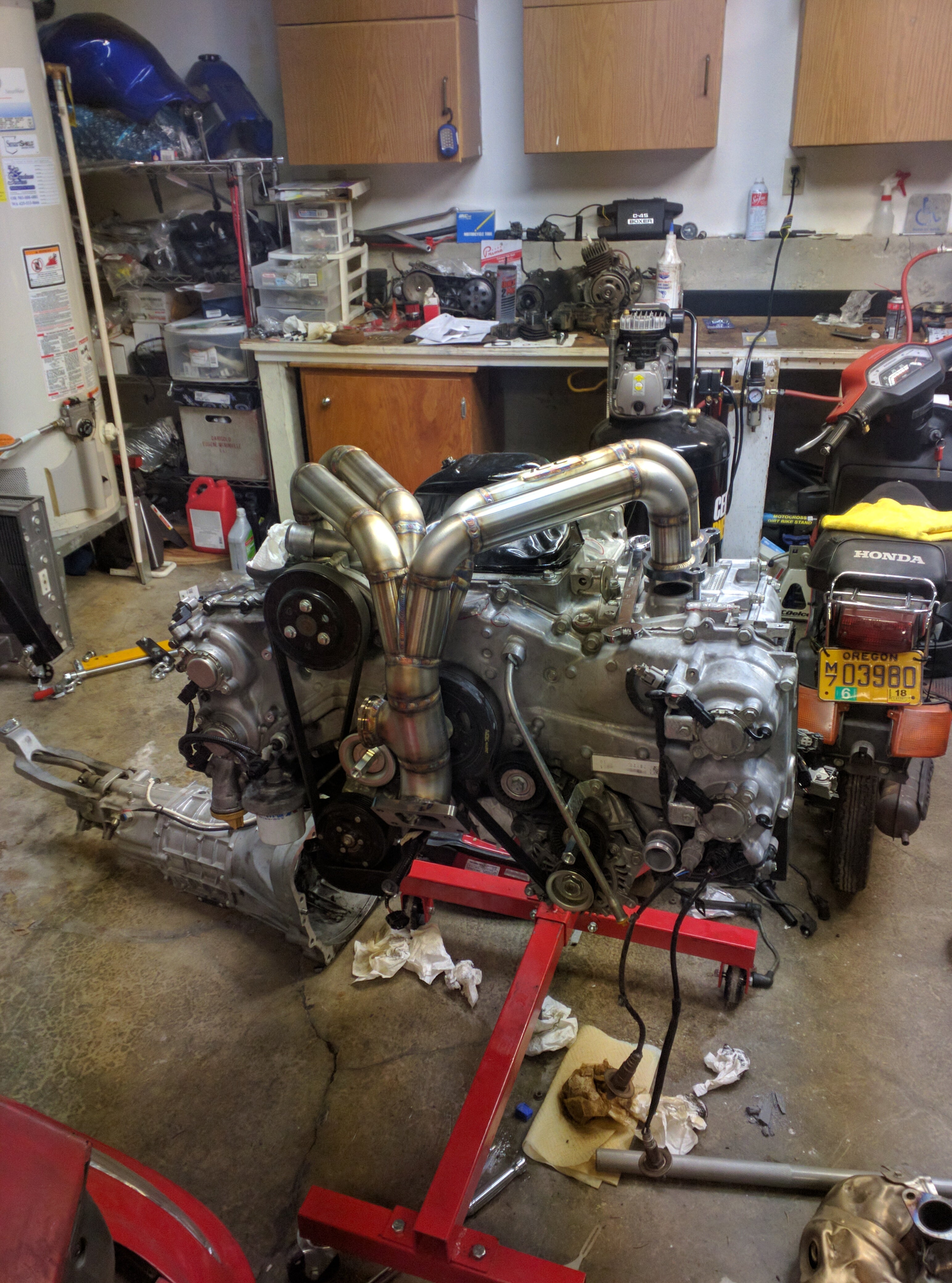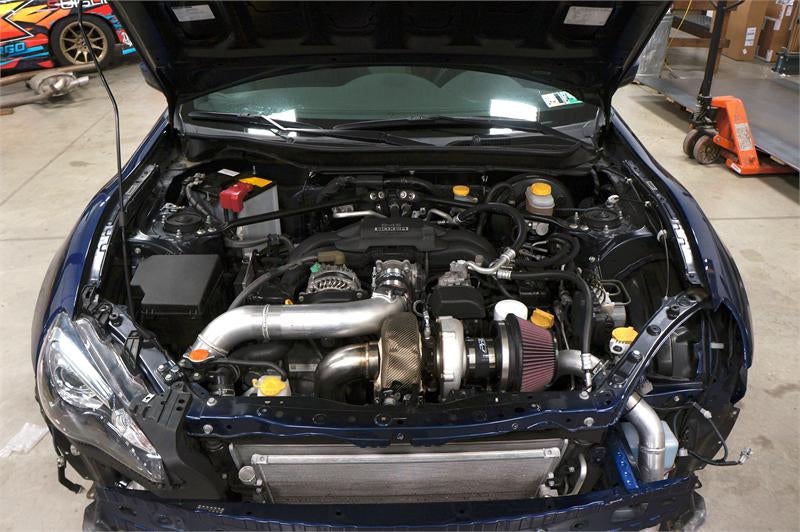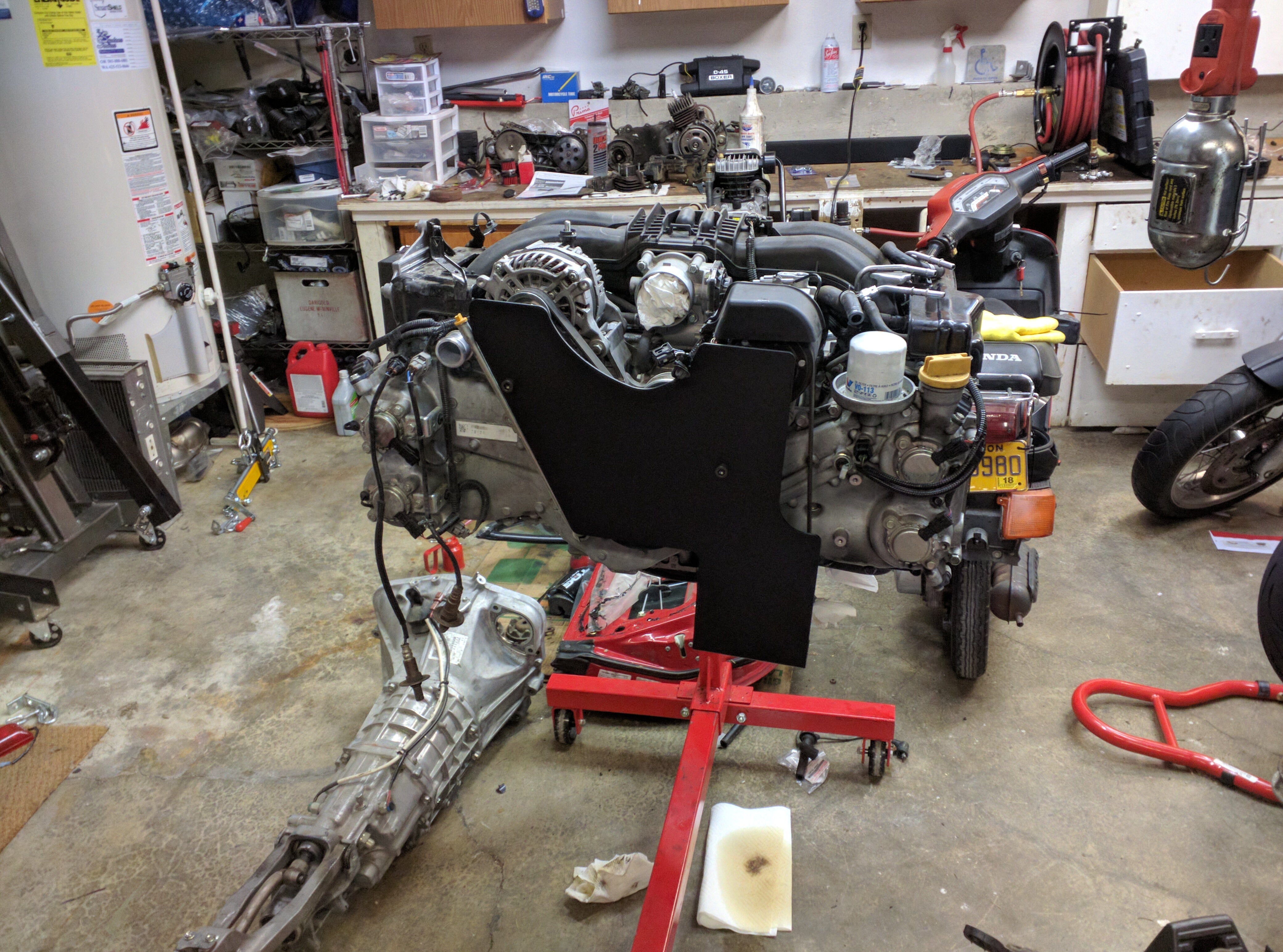 by "Decay buys too many beaters" (decay)
by "Decay buys too many beaters" (decay)
Published 03/09/2017 at 19:25
 by "Decay buys too many beaters" (decay)
by "Decay buys too many beaters" (decay)
Published 03/09/2017 at 19:25
No Tags
STARS: 11
TL/DR The other day I started mocking up all my turbo components for the FR-S. (Spare motors are awesome BTW)

There has always been a debate when it comes to the FR-S/BRZ twins over power. On one hand, it’s the hardtop Miata enthusiasts have been dreaming of for years, and on the other, it’s pretty damn slow for being the only real sports car in either Subaru or Toyota’s lineup (no, the WRX doesn’t count). It has become clear at this point, that any factory “hot” versions will leave the drivetrain largely alone, which leaves the aftermarket for anyone wanting a little more kick out of the platform. I’ve always loved the way the car handles but wished it had just a little more pull out of corners, I’m not looking to run 10s or spin the tires through 5th gear, just a bit more pickup. Now, the smart option (I’ve been told, ad nauseum) would be to go out and buy a WRX/Mustang/Camaro/whatever, but none of those really check all my boxes. As such I’ve decided to take matters into my own hands.

Now, the first question for people who want more power from the platform is whether to turbocharge or supercharge. With probably a dozen or more of each type kit available there certainly are quite a few options. I’ve driven a number of supercharged FA20s and none of them really “felt” all that special to me. The roots/twinscrew blowers had a good kick down low, but many ran out of steam up top. The centrifugal blowers make good peak numbers but just don’t feel that fast with such a linear torque gain.
This leaves turbocharging, which, properly done, should give the low down torque of a roots blower and the top end of a centrifugal. The problem with turbochargers is that they make a LOT of heat, go look around the engine bay of a factory turbo car and see just what kinds of lengths OEMs go to for heat management. One way around this is to mount the turbo down by the transmission, away from any heat sensitive components in the engine bay. Unfortunately this places the turbo really far away from the exhaust ports so spool happens later. Also due to the placement, charge piping needs to be significantly longer which leads to more lag.

The other option is to place the turbo right in front of the engine, as close to the exhaust ports as possible. This gives the best possible response, but also injects a ton of heat right into the engine bay.

I chose the latter option, which brings up the question “how do I manage all that heat?” First off, I’m preemptively installing some heat shielding to block the engine from radiant heat

Secondly, I’ll be putting some heat extracting vents into the low pressure zone on the front of the hood.

And finally I’m currently having all the hot parts in the bay ceramic coated in hopes that it will keep as much heat in as possible. If I need to, the next step is to upgrade radiator fans and play with the calibration to turn them on earlier.
Overall goal for the project is to get 300 or so HP with room to upgrade and more importantly reliability on track. That last point is the hard part, not a lot of people have successfully been able to make turbos work on track, but I don’t think I’ve seen anyone with as much preemptive heat management planning yet. We’ll see, I’ll update once things start getting bolted on in earnest.
 "e36Jeff now drives a ZHP" (e36jeff)
"e36Jeff now drives a ZHP" (e36jeff)
03/09/2017 at 19:31, STARS: 1
Any particular reason why you aren’t going with an air-to-water cooling system? I’ve always been of the belief that removing volume behind the turbo is a good thing.
 "Decay buys too many beaters" (decay)
"Decay buys too many beaters" (decay)
03/09/2017 at 19:37, STARS: 1
A few reasons. First off the added complexity gives more points of potential failure. Since the plan is to use this on track, an air to air system gives me one less thing that has to be monitored closely. Second, usually air to water is heavier. The main reason however, is that under heavy track usage most air to water systems will heat soak, whereas an air to air will keep pulling cooling capacity from ambient air.
 "bob and john" (bobandjohn)
"bob and john" (bobandjohn)
03/09/2017 at 19:44, STARS: 1
neat!
also, I did another dumb today.
take a wild guess as to what
 "Decay buys too many beaters" (decay)
"Decay buys too many beaters" (decay)
03/09/2017 at 19:45, STARS: 1
You bought a 5th (6th?) SV?
You bought a Ducati motor?
You bought a tiny turbo off of ebay?
 "bob and john" (bobandjohn)
"bob and john" (bobandjohn)
03/09/2017 at 19:46, STARS: 1
closest on the first,.
but no, honda CB-1
 "Decay buys too many beaters" (decay)
"Decay buys too many beaters" (decay)
03/09/2017 at 19:51, STARS: 0
Oh cool! I’d love to own a small displacement 4 someday. A few friends and I have been looking in to the costs associated with bringing over some of the bikes from the Japanese 250cc class sportbike wars. ‘dat 20000 rpm redline!
!!! UNKNOWN CONTENT TYPE !!!
 "bob and john" (bobandjohn)
"bob and john" (bobandjohn)
03/09/2017 at 20:06, STARS: 1
I want one of those so badly....but they are like 8K CAD ....
 "Decay buys too many beaters" (decay)
"Decay buys too many beaters" (decay)
03/09/2017 at 20:11, STARS: 0
I’m really hoping the push to smaller bikes we’re seeing will reignite another tiny bike war.
 "SidewaysOnDirt still misses Bowie" (sidewaysondirt)
"SidewaysOnDirt still misses Bowie" (sidewaysondirt)
03/09/2017 at 20:42, STARS: 1
This is great. Can’t wait to see more from it!
 "Decay buys too many beaters" (decay)
"Decay buys too many beaters" (decay)
03/09/2017 at 20:50, STARS: 0
I am excited, the biggest mental block I had was what I’d do if an engine popped. Now I’ve got a spare, so I’m free to do what I’ve wanted for a while.
 "uofime-2" (uofime-2)
"uofime-2" (uofime-2)
03/10/2017 at 10:02, STARS: 0
I like where you’re going with this heat management wise. You could go as far as adding a full duct that seals to the hood and goes down to around the radiator as much as is practical. Then you can even use the radiator fans to blow heat from the turbo out when you’re in traffic.
Don’t love the angle of the wastegate but it also looks huuuuge so it probably won’t matter.
Get a heat shield on the air cleaner and duct air from somewhere high pressure and cool.
Get a good oil cooler, turbos simultaneously dump gobs more heat in the oil system and make the engine less tolerant of thinned out, hot oil
 "Decay buys too many beaters" (decay)
"Decay buys too many beaters" (decay)
03/10/2017 at 10:56, STARS: 0
Yeah one on my gripes was the wastegate angle, but it’s a 45mm turbosmart, so it should flow just fine. Air cleaner is going to be right in front of the factory intake position, so will see plenty of airflow.
Also I’ve already got an oil cooler, currently a 16row series 6 Setrab. On Install I’ll be adding provisions to go to a larger core if needed. (Probably will be)
 "uofime-2" (uofime-2)
"uofime-2" (uofime-2)
03/10/2017 at 11:06, STARS: 1
Yeah you see that all the time. It will have plenty of authority to prevent creep the issue with oversized gates is maintaining tight control, might be annoying to tune, but I’d guess it’ll be fine.
Yeah, that 16 row is not rated for the amount of power you’re planning to make.
I’m putting together a kit with one of their 25 row coolers now (which is the reason I’m oddly familiar with their ratings ha ha)
 "Decay buys too many beaters" (decay)
"Decay buys too many beaters" (decay)
03/10/2017 at 12:18, STARS: 0
Well it seems to do “ok” with no oil cooling from the factory until you start doing road course work. So initially, autocross, street lols, short technical track It’ll be fine so long as I monitor pressure.
Then again, while I’m wating for parts to coat, might hit “fuck it” and buy a 34 row (I have a thermostat and can block off the core, not all that worried about overcooling)
 "uofime-2" (uofime-2)
"uofime-2" (uofime-2)
03/10/2017 at 12:30, STARS: 1
Holy mother of god haha a 34 row!
 "Decay buys too many beaters" (decay)
"Decay buys too many beaters" (decay)
03/10/2017 at 12:43, STARS: 0
Well not like you can overcool on a track, and the bigger I go the less pressure drop across the core.
 "uofime-2" (uofime-2)
"uofime-2" (uofime-2)
03/10/2017 at 12:52, STARS: 0
True, but it is weight, oil volume (mostly just a cost concern) , space and likely restricting flow to your radiator
 "Decay buys too many beaters" (decay)
"Decay buys too many beaters" (decay)
03/10/2017 at 12:59, STARS: 1
Well there is not much weight difference honestly, between 25 and 34. The up side of running a larger than recommended oil cooler is that I might be able to make a 34 row work behind the radiator as long as I have a pull through fan.
 "JGrabowMSt" (jgrabowmst)
"JGrabowMSt" (jgrabowmst)
03/20/2017 at 00:35, STARS: 1
How did I miss this?
I have been in an FR-S that was built for stupid power. I’ve been in fast cars before, but the FR-S was a wildly different package of platform and power delivery. Taking a 2800lb car and absolutely mashing 800hp out of it is ludicrous.
I could dig up a handful of pictures of it if you want to see how it ended up being put together. The turbo was front mounted, IIRC, slightly off center. I’m certainly concerned for the life of the transmission with how quickly it would build boost, but if your goal is 300hp, I would expect you’ll be running a medium sized turbo at relatively low boost, so heat may not be as much an issue so much as making it all fit.
The fuel systems in those cars is just ridiculous. The amount of fuel it dumps in just to start is crazy. I would just suggest a larger radiator and a lower temp thermostat before playing around with the fans if you’re looking to control the temps more. The annoyances of getting the larger radiator or swapping the thermostat is nothing compared to dealing with alternator or battery issues because the fans draw significantly more power than the OEM ones. Unfortunately there isn’t much development in the fan blade department of the automotive industry. There are tons of fan blade designs that could make them quieter, move more volume, or even finding a smaller hub in order to maximize cooling efficiency. Never seen any of it apply to automotive though.
 "Decay buys too many beaters" (decay)
"Decay buys too many beaters" (decay)
03/20/2017 at 00:56, STARS: 0
I’ll be running a gtx2867r, so a nice small turbo. Now on the cooling front, I hope to stay with OEM rad at first and I’ll see how I can optimize with ducting and venting. I’m a big believer in changing things as needed, plus want to a kid scope creep wherever possible.
Interesting thoughts on the thermostat. Why? I’m really only concerned about steady state high load overheating, a lower temp thermostat might buy some time (minutes really) but the system thermal capacity remains unchanged.